Chrysler 300
Front Brake Pads Replacement Guide
How to change the front disc brake pads
on a 2nd generation 2011 to 2017 Chrysler 300 sedan with the part numbers.
By Paul B. Michaels Author & Photographer Auto Mechanic Since 1989 |
||
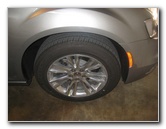 2016 Chrysler 300 Front Wheel |
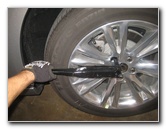 Slightly Loosen Lug Nuts |
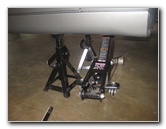 Raise Front of Car |
| This
automotive maintenance tutorial was specifically written to assist
owners of the second generation (2011, 2012, 2013, 2014, 2015, 2016
& 2017) Chrysler 300, 300C or 300S sedan in changing the front
disc brake pads and lubricating the caliper slider pins. Owners of other Chrysler, Dodge, Jeep and RAM vehicles such as the Town & Country, 200, Pacifica, Avenger, Charger, Journey, Challenger, Dart, Durango, Magnum, Grand Caravan, Grand Cherokee, Renegade, Wrangler, Compass, Liberty, Patriot, ProMaster, 1500 and C/V Tradesman minivan may also find these DIY instructions to be helpful. The tools and other items needed to complete this procedure include a floor jack, two jack stands, a lug nut wrench, a 13mm socket with a 3/8" drive ratcheting, an 18mm wrench, a "C" or "F" clamp and a tube of brake caliper grease. |
||
|
|
||
Please verify the compatible replacement part numbers for your Chrysler 300 sedan by using the Amazon Part Finder website. The correct brake pads may vary depending on the model year, trim level and transmission type (RWD - rear wheel drive or AWD - all wheel drive). A few compatible brake pads for this 2016 Chrysler 300C RWD with their part numbers are as follows: Wagner QC1058, Raybestos ATD1058C, Power Stop Z23-1058, Akebono ACT1058, Bosch BC1058 and ACDelco 17D1058C. |
||
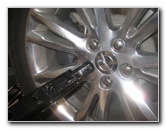 Spin Off 5 Lug Nuts |
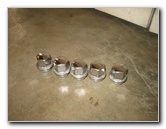 5 Lug Nuts Removed |
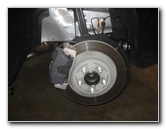 Caliper, Bracket & Rotor |
|
The first few steps are to park the vehicle on a level surface, engage the
emergency / parking brake and
chock
both sides of the rear wheel to prevent the vehicle from moving. Then slightly loosen the 5 lug nuts on the front wheel by turning them counterclockwise with the tire iron. Raise the front of the car with the floor jack and securely support it with the two jack stands. I prefer to work on one side of the vehicle at a time to keep three wheels on the ground for extra safety. Continue spinning off the 5 lug nuts in the counterclockwise direction and set them aside in a safe place. Pull off the front wheel to reveal the caliper, bracket, rotor and suspension. |
||
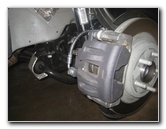 Front Brake Caliper |
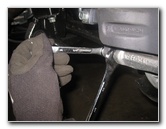 Loosen Lower Caliper Bolt |
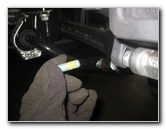 Lower 13mm Bolt Removed |
|
The front brake caliper is held in place to the bracket by two bolts on the
back side with the bolt heads facing in towards the engine bay. Loosen the lower caliper bolt by turning it clockwise (as seen from the outside of the vehicle) with the 13mm socket and a 3/8" drive ratcheting wrench. If the caliper slider pin rotates as you are trying to loosen the caliper bolt, hold it in place with a thin 18mm cone spanner wrench. Then loosen the upper 13mm caliper bolt by rotating it clockwise (as seen from the outside of the vehicle). |
||
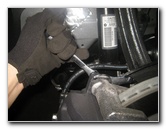 Loosen Upper Caliper Bolt |
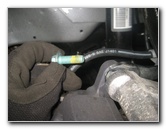 Spin Out Top 13mm Bolt |
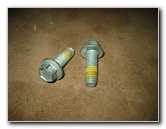 Two Caliper Bolts Removed |
| Spin out the two caliper bolts and set them aside in a safe place. | ||
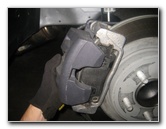 Pull Caliper Off Pads |
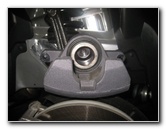 Rest Caliper On Suspension |
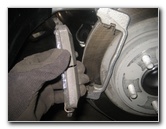 Remove Old Outer Pad |
| Pull the caliper out of the bracket and carefully rest it on the suspension or suspend it from the spring with a bungee cord. | ||
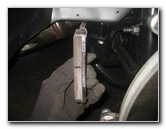 Wear Bar - Top Inner Pad |
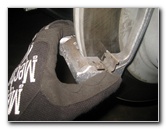 Replace Pad Abutment Clips |
 Pull Out Caliper Slider Pins |
|
Pull the old outer and inner brake pads out of the bracket. Make a mental note of where the wear indicator or "squeal" bars are located on the old pads. On this 2016 300C, the wear bar was situated at the top of the inner brake pad. I'd recommend buying the Wagner QC1058 "ThermoQuiet" brake pads since they have great reviews on Amazon and they don't require any backing plates, shims or disc brake quiet gel due to the built in insulators. If your new set of pads included replacement hardware, pull the old metal pad abutment or "anti-rattle" clips from the top and bottom of the bracket before installing the new ones in their place. Apply a thin layer of brake parts lubricant grease to any area where pad abutment clips will come in contact with the bracket or the new pads. In order for the caliper to operate smoothly, the two caliper slider pins need to be well lubricated.Pull the upper and lower caliper slider pins out of their rubber dust boots, apply a thin layer of brake parts lubricant grease to each before pushing them back in. |
||
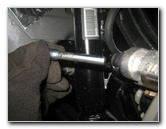 Lubricate & Replace Pins |
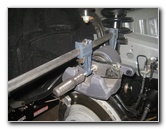 Attach "C" Clamp To Caliper |
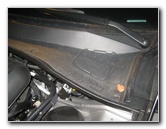 Driver Side Plastic Cowl |
|
In order for the caliper to fit over the thicker new brake pads, the caliper piston needs to be compressed back. Attach the "C" or "F" clamp to the caliper using the back of an old brake pad to evenly distribute the pressure across the piston. |
||
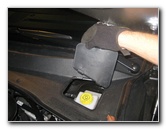 Pull Off Access Cover |
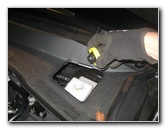 Twist Off Brake Fluid Cap |
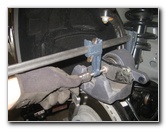 Compress Caliper Piston |
|
Move to the right rear area of the engine bay (closest to the driver's seat)
and open the brake fluid reservoir access panel on the plastic cowl. Set the access cover aside in a safe place. Twist off the brake fluid reservoir cap in the counterclockwise direction. Removing the reservoir cap will allow the brake fluid to more easily travel backwards through the hose when you compress the piston. Slowly turn the "C" or "F" clamp handle in the clockwise direction to retract the piston back in to the caliper.Continue compressing the piston until it is just about flush with the rubber dust boot surrounding it. Try to avoid pinching or damaging the rubber dust boot. |
||
|
|
||
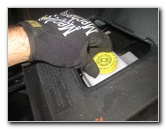 Replace Reservoir Cap |
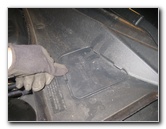 Replace Access Panel |
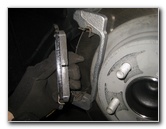 Install New Outer Pad |
|
Replace the reservoir cap as soon as possible by twisting it on the clockwise direction since brake fluid is hygroscopic (readily absorbs moisture from the air). Replace the plastic brake fluid reservoir access panel in to the cowl. Thoroughly clean off the brake rotor, caliper bracket, brake caliper assembly and the lug nut studs with brake parts cleaner spray. Do not use compressed air or blow with your mouth to clean off the brake parts since breathing in brake dust can be harmful to your health. Brake dust can be carcinogenic (cancer causing) if inhaled.Apply a thin layer of brake parts lubricant to any area where there is metal to metal contact such as the outer lip of the caliper piston. Do not apply brake caliper grease to the friction surface of the new pads.
To remove the existing rotors and install new ones, remove the two bolts on the rear of the caliper bracket that attach it to the steering knuckle. Then loosen the old rotor with a rubber mallet, pull it off, and slide the new one in its place. |
||
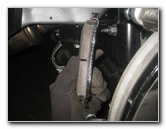 Wear Bar - Top Inner Pad |
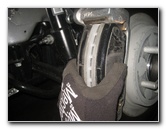 Push Pads Against Rotor |
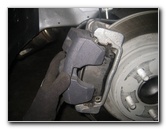 Lower Caliper Over Pads |
| Install the new
brake pads in to the bracket with the wear bar situated at the top of the
new inner brake pad. Push the two brake pads together until they are flush against the rotor. Carefully lower the brake caliper over the new brake pads and in to the bracket.If the caliper won't fit over the new pads, you might need to push the piston back a bit further. Line up the bolt holes in the caliper with their corresponding holes in the slider pins within the bracket. |
||
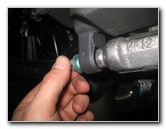 Spin In Bottom Bolt |
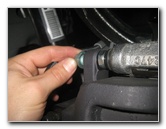 Spin In Top Caliper Bolt |
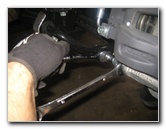 Tighten Lower Bolt |
| Spin the two
caliper bolts by hand a few turns in the counterclockwise direction (as seen
from the outside of the vehicle) to prevent them from becoming cross
threaded. Tighten the caliper bolts by rotating them counterclockwise (as seen from the outside of the vehicle) with the 13mm socket and ratcheting wrench to just past hand tight or about 44 ft-lbs of torque. If the caliper slider pin starts to turn as you are attempting to tighten the caliper bolts, you can hold it in place with an 18mm wrench. Double check that both the upper and lower caliper bolts are tight before moving on to the next steps. |
||
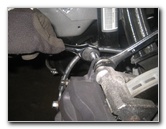 Tighten Upper 13mm Bolt |
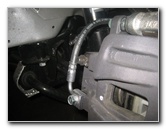 Rubber Valve Cap |
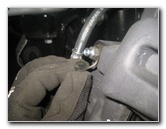 Brake Fluid Bleeder Valve |
|
If your brake pedal previously felt soft or spongy, the brake fluid may be
contaminated with water or the brake lines may contain some air bubbles. It would be best to bleed the brake lines at this time in order to flush out the old fluid and replace it with fresh DOT3 brake fluid. For more on this topic, check out my Brake Line Fluid Bleeding With An Assistant DIY Guide or alternatively my Brake Line Fluid Bleeding With A Power Bleeder Guide. The brake fluid bleeder valve is located underneath a rubber cap on the back side of the caliper just below the upper caliper bolt. |
||
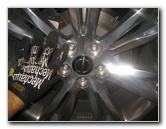 Push On Front Wheel |
 Spin On 5 Lug Nuts |
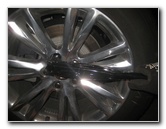 Slightly Tighten Lug Nuts |
| Replace the front
wheel and spin on the 5 lug nuts a few turns by hand in the clockwise
direction to prevent them from becoming cross threaded. Slightly tighten the lug nuts in the clockwise direction in a "star" or "criss-cross" pattern with the tire iron. |
||
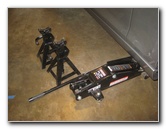 Lower Car From Stands |
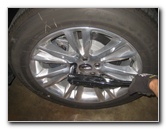 Torque To 110 lb-ft |
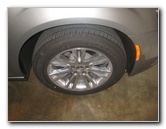 Front Brake Pads Replaced |
|
It would be best to use a torque wrench or an impact wrench with a torque stick to properly tighten the lug nuts. Sit in the driver's seat of the vehicle and pump the brake pedal a few times to restore the brake line pressure. Check the brake fluid in the reservoir and verify that it is at the proper level. If it is low, pour in some DOT 3 fluid. To break in your new front brake pads, just drive normally for the first few hundred miles while trying to avoid any hard or "panic" stops which might glaze over the new pads and cause them to be noisy and/or not perform as well. It's also a good idea to regularly check your driveway or garage for drops of fresh brake fluid which may indicate a leak, check the brake fluid level in the reservoir, and also verify that the lug nuts are still tight. For more, check out all of my
2011-2017 Chrysler 300 DIY Repair & Maintenance Guides. |
||
| If you found this guide to be helpful,
please consider making a small donation by clicking on the PayPal.com
"Donate" button located to the right of this paragraph. Thank you!
(Note: I am not a registered charity. Donations are not tax deductible.) |

